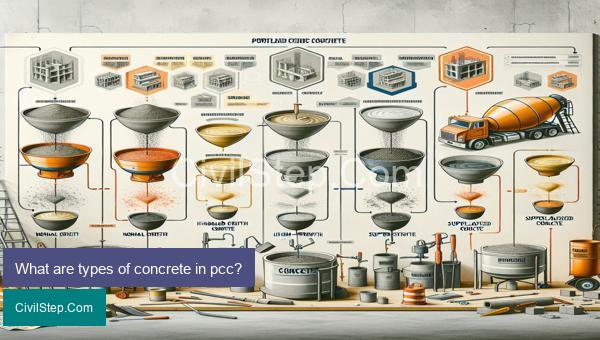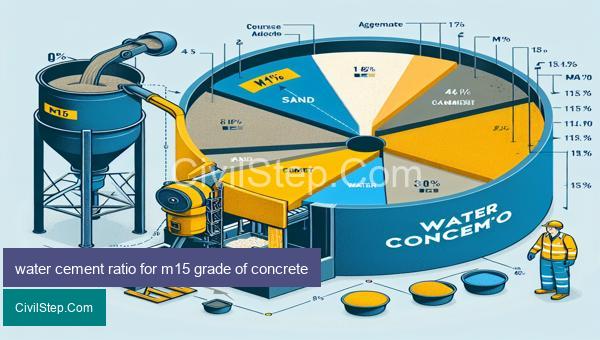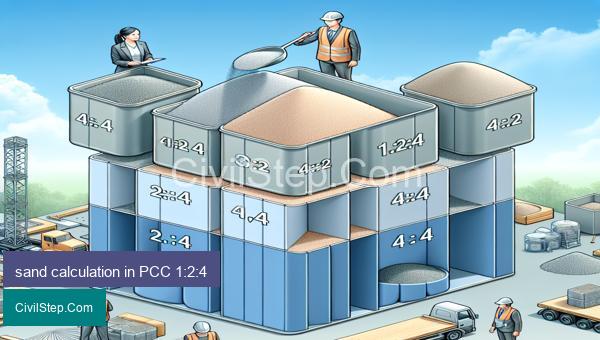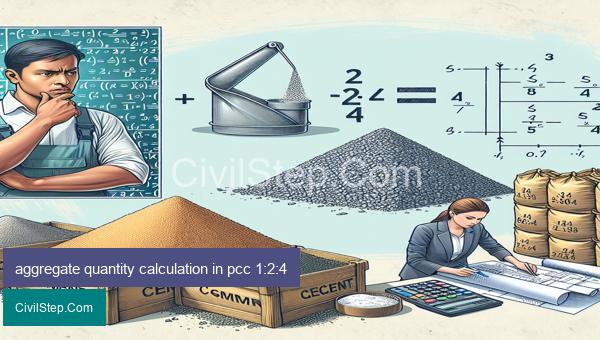
PCC (Plain Cement Concrete) is the most commonly used construction material for the foundation, flooring, and other structural elements of a building. One of the crucial components of PCC is cement, which forms the binding agent in the mixture. It is essential to accurately calculate the quantity of cement in PCC to ensure the structural integrity and durability of the building. In this article, we will delve into the various factors and methods involved in determining the correct amount of cement in PCC, providing a comprehensive understanding of this crucial aspect of construction.
How to calculate quantity of cement in PCC

PCC, or plain cement concrete, is a commonly used construction material for various building elements such as foundations, columns, and slabs. Cement is a crucial component in PCC as it provides strength and binding properties to the concrete. Therefore, it is essential to accurately calculate the quantity of cement required for a PCC project to ensure a durable and cost-effective structure. In this article, we will discuss the step-by-step process of calculating the quantity of cement in PCC.
Step 1: Determine the Volume of PCC
The first step in calculating the quantity of cement in PCC is to determine its volume. The volume of PCC can be calculated by multiplying the length, width, and thickness of the concrete structure. For example, if the dimensions of a PCC slab are 6 meters (m) in length, 3 m in width, and 0.15 m in thickness, then the volume of PCC will be:
Volume = Length x Width x Thickness
= 6 m x 3 m x 0.15 m
= 0.9 cubic meters (m³)
Note: Always use consistent units while calculating the volume.
Step 2: Determine the Ratio of Cement to Aggregate
The next step is to determine the ratio of cement to aggregates (sand and coarse aggregates) in the PCC mix. The most commonly used ratio is 1:4:8, where one part of cement is mixed with four parts of sand and eight parts of coarse aggregates. This means that for every 1 cubic meter of PCC, we will need 1/13 of cement (1 part out of 13 parts) by volume.
Step 3: Calculate the Amount of Cement
To calculate the amount of cement required for PCC, we will use the following formula:
Quantity of cement = (Volume of PCC x Cement ratio)/Total ratio
Substituting the values in the formula, we get:
Quantity of cement = (0.9 m³ x 1/13)/1+4+8
= 0.05 m³
To convert it into cubic feet, multiply the value by 35.3147, as 1 cubic meter is equal to 35.3147 cubic feet.
Quantity of cement = 0.05 m³ x 35.3147 = 1.767 cubic feet (ft³)
Step 4: Consider the Wastage
It is common to have some wastage during the construction process, so it is advised to add an additional 5-8% of cement to the calculated quantity to account for any potential losses. In our example, we will take 8% as the wastage, so the total quantity of cement required will be:
Total quantity of cement = 1.767 ft³ + (8/100) x 1.767 ft³
= 1.912 ft³ (rounded off to three decimal places)
Therefore, the final quantity of cement required to make 1 cubic meter of PCC with a 1:4:8 mix ratio is 1.912 cubic feet.
Note: The wastage factor may vary depending on the construction site and project complexity. It is always advisable to consult with a structural engineer before finalizing the wastage percentage.
Conclusion
Calculating the quantity of cement in PCC is a crucial step in the construction process. It ensures that the right amount of cement is used
What are types of concrete in pcc?

Concrete is a construction material composed of cement, fine aggregates (sand), coarse aggregates (gravel or crushed stones), and water. It is widely used in the construction of buildings, roads, bridges, and other structures due to its strength, durability, and versatility. PCC or Plain Cement Concrete is the most commonly used type of concrete in civil engineering projects. It is a basic form of concrete that is used as a base for different types of structures.
There are various types of concrete used in PCC, and each type has its own unique properties and advantages. Let’s take a look at some of the commonly used types of concrete in PCC:
1. Normal Concrete: This is the most commonly used type of concrete in PCC. It is a mixture of cement, sand, and coarse aggregates with a water-cement ratio ranging from 0.45 to 0.7. Normal concrete has a compressive strength of 10-40 MPa and is used in the construction of residential, commercial, and industrial buildings.
2. Reinforced Concrete: Reinforced concrete is a type of concrete in which steel reinforcement bars or fibers are embedded to increase its strength and durability. It is used in the construction of heavy structures such as bridges, dams, and high-rise buildings. Reinforced concrete has a higher compressive strength of 30-50 MPa.
3. Plain Concrete: Plain concrete is a simple type of concrete mixture without any reinforcement. It is mainly used for non-load bearing structures such as pavements, driveways, and sidewalks. Plain concrete has a lower compressive strength of around 5 MPa.
4. Light-Weight Concrete: Light-weight concrete is a type of concrete that is made by using light binders or aggregates. It has a lower density and is used in the construction of lightweight structures such as precast panels, blocks, and slabs. The compressive strength of light-weight concrete is around 22 MPa.
5. High-Strength Concrete: High-strength concrete is a type of concrete that has a higher compressive strength than normal concrete. It is achieved by using high-quality materials and reducing the water-cement ratio. High-strength concrete is used in the construction of high-rise buildings and structures that require high load-bearing capacity.
6. Self-Compacting Concrete: Self-compacting concrete (SCC) is a type of concrete that flows and fills in the formwork under its self-weight without the need for any external compaction. It is used in the construction of highly reinforced structures, where traditional methods of compaction are difficult. SCC has a compressive strength of 20-45 MPa.
7. Roller Compacted Concrete: Roller Compacted Concrete (RCC) is a type of concrete that is mixed and then compacted with the help of a roller to reduce air pockets and achieve a dense and impermeable structure. It is commonly used in the construction of dams, parking lots, and pavements.
In conclusion, PCC is a versatile construction material that can be modified to meet specific requirements by using different types of concrete. The selection of the appropriate type of concrete for PCC depends on factors such as the type of structure, the intended use, and the load-bearing capacity. Each type of concrete has its own advantages and should be carefully chosen based on the project requirements.
cement consumption in PCC 1:2:4

Cement consumption in PCC 1:2:4 refers to the amount of cement needed for the production of Plain Cement Concrete with a ratio of 1 part cement to 2 parts fine aggregate (sand) to 4 parts coarse aggregate (stone chips or gravel). This type of concrete is commonly used in construction projects for various purposes such as foundation, flooring, and paving.
The consumption of cement in PCC 1:2:4 is directly related to the strength and durability of the concrete. The amount of cement used significantly affects the compressive strength, tensile strength, and overall quality of the concrete. Therefore, it is crucial to determine the correct amount of cement needed for the desired strength and durability of PCC 1:2:4.
The cement content in PCC 1:2:4 is typically measured in terms of volume, with a commonly used unit being cubic feet. The amount of cement required for a unit volume of PCC 1:2:4 depends on various factors, such as the quality of cement, water-cement ratio, and type and grading of aggregate.
The water-cement ratio is a crucial factor in determining the amount of cement needed in PCC 1:2:4. A higher water-cement ratio requires more cement to achieve the desired workability and strength. This is because excess water weakens the hardened concrete and affects its durability. Therefore, it is recommended to keep the water-cement ratio between 0.4 to 0.6 for PCC 1:2:4, depending on the site conditions.
The quality of cement used also plays a vital role in cement consumption in PCC 1:2:4. Cement with a higher compressive strength will require a lesser amount of cement compared to lower-grade cement. This is because high-grade cement has a higher binding capacity and can produce more durable and stronger concrete.
The type and grading of aggregate used in PCC 1:2:4 also affect the amount of cement needed. If the coarse aggregate has a higher specific gravity, it will require more cement to fill the voids and achieve a denser concrete mix. Similarly, the grading of fine aggregate also plays a role in determining cement consumption. A well-graded fine aggregate requires less cement compared to a poorly graded fine aggregate.
The climate and weather conditions at the construction site also influence the amount of cement needed for PCC 1:2:4. In areas with hot and dry weather, more water may be needed to maintain the desired workability, which in turn would require more cement to maintain a proper water-cement ratio.
In conclusion, the amount of cement consumption in PCC 1:2:4 depends on various factors such as water-cement ratio, quality of cement, type and grading of aggregate, and climate conditions. It is essential to determine the correct amount of cement required to produce high-quality and durable PCC 1:2:4, which is crucial for the success of any construction project.
water cement ratio for m15 grade of concrete

Water cement ratio is an important aspect in the design of concrete for any grade. For M15 grade of concrete, which refers to the mix design of concrete with a compressive strength of 15 MPa (megapascals), the water cement ratio plays a crucial role in determining the strength, workability, and durability of the concrete.
The water-cement ratio is the ratio of the weight of water to the weight of cement used in the concrete mix. It is denoted by “W/C” and is expressed as a decimal or percentage. In the case of M15 grade of concrete, the recommended water-cement ratio is 0.55, which means that for every 1 kg of cement used, 0.55 kg of water is added.
The water-cement ratio impacts various properties of concrete, including strength, workability, and durability. Here are some of the effects of water-cement ratio on concrete:
1. Strength: The water-cement ratio directly influences the strength of concrete. A lower water-cement ratio results in higher strength and vice versa. In M15 grade of concrete, the recommended water-cement ratio of 0.55 ensures good strength without compromising the workability of the concrete.
2. Workability: Workability of concrete refers to its ability to be easily mixed, placed, compacted and finished. A higher water-cement ratio results in better workability as it makes the concrete more fluid. However, an excess of water can lead to segregation, bleeding, and reduced strength. The recommended water-cement ratio of 0.55 for M15 grade of concrete maintains a good balance between workability and strength.
3. Durability: The water-cement ratio also affects the durability of concrete. Excess water in the concrete mix can cause shrinkage, cracking, and reduce the resistance to chemicals, weathering, and abrasion. The recommended water-cement ratio for M15 grade of concrete ensures good durability and reduces the risk of cracks and deterioration.
Besides the recommended water-cement ratio, other factors such as the quality of materials, temperature and humidity also influence the actual amount of water needed in the concrete mix. It is essential to maintain the correct water-cement ratio during mixing, placing, and curing of concrete to achieve the desired strength and durability.
In conclusion, the water-cement ratio of 0.55 is considered optimum for M15 grade of concrete. However, it is essential to have a proper mix design and perform regular quality control tests to ensure a consistent and appropriate water-cement ratio in the concrete mix.
What is lean concrete in pcc?

Lean concrete, also known as dry lean concrete or lean mix concrete, is a form of concrete that has a lower cement content than traditional concrete mixtures. It is typically used for non-structural elements in construction projects, such as sub-bases, footings, and pavements.
Lean concrete is made by mixing cement, sand, and coarse aggregates in specific proportions, typically with a very low water-cement ratio. This results in a dry, stiff mixture that has a lower slump than traditional concrete. The use of higher amounts of aggregates and lower cement content reduces the overall cost of the concrete mixture.
One of the main purposes of using lean concrete is to provide a stable and strong base for the construction of structural elements. The low water-cement ratio ensures that the concrete does not shrink significantly during the curing process. This helps in preventing cracks, which can lead to structural issues in the long term.
Another advantage of using lean concrete is that it has a faster setting time compared to traditional concrete mixtures. This allows for faster construction timelines and minimizes project delays. Additionally, the lower cement content reduces the heat of hydration, which can be beneficial in hot weather conditions.
Lean concrete is also used as a base material for asphalt pavements. It provides a stable and strong foundation for the road surface, enhancing its durability and longevity. The lower water-cement ratio also makes lean concrete less prone to erosion, making it an ideal choice for pavements in areas with heavy traffic.
One of the key benefits of lean concrete is its cost-effectiveness. The reduced use of cement and higher amounts of aggregates make it a more economical option for non-structural construction elements. It also helps in reducing the overall carbon footprint of the project, making it a more sustainable choice.
However, it is important to note that lean concrete is not suitable for all construction projects. The lower cement content can result in a lower compressive strength compared to traditional concrete, making it less suitable for structural elements. It is essential to consult a structural engineer to determine if lean concrete is a suitable option for a specific project.
In conclusion, lean concrete is a cost-effective and sustainable alternative to traditional concrete mixtures for non-structural construction. It provides a stable and strong base for various elements and has a faster setting time, making it a desirable choice for construction projects. Its use should be carefully evaluated and determined by a trained professional to ensure its suitability and effectiveness.
what is ordinary concrete?

Ordinary concrete, also known as plain concrete, is the most commonly used type of concrete in construction. It is a composite material composed of coarse aggregate (such as gravel or crushed stone), fine aggregate (such as sand), cement, and water. It is widely used in various construction projects such as buildings, roads, bridges, and dams.
The main component of ordinary concrete is cement, which acts as a binder that holds the aggregate together. The most commonly used type of cement in ordinary concrete is Portland cement, which is made by heating limestone and clay in a kiln and then grinding it into a fine powder. The proportions of the ingredients used in ordinary concrete may vary, but typically it consists of 10% to 15% cement, 60% to 75% aggregate, and 15% to 20% water.
Though it may seem simple, the process of making ordinary concrete involves a precise combination of ingredients and a thorough mixing process. The aggregate and sand are first mixed together, followed by the addition of cement and water. The mixture is then stirred continuously until a homogeneous consistency is achieved. This process is known as hydration, where the cement particles react with water to form a strong bond, creating the solid structure of the concrete.
The strength and durability of ordinary concrete largely depend on the quality of the ingredients used and the manner in which it is mixed and cured. Generally, ordinary concrete can withstand compressive loads of 2500 to 5000 pounds per square inch. It is suitable for use in most construction projects, but it may not be suitable for heavy structural elements or extreme weather conditions.
One of the main advantages of ordinary concrete is its versatility. It can be molded into various shapes and sizes, making it suitable for a wide range of construction needs. It is also readily available and cost-effective compared to other types of concrete. However, it has a relatively low tensile strength, which means it may crack or break under tension. To offset this, reinforcing materials such as steel bars may be added to improve its strength.
In conclusion, ordinary concrete is a fundamental building material with a long history of use in construction. Its widespread availability, versatility, and reasonable cost make it a popular choice for many construction projects. While it may not be suitable for all applications, it remains an essential and reliable material for various construction needs.
calculation of cement quantity in pcc 1:2:4

PCC (Plain Cement Concrete) is a commonly used construction material in civil engineering projects. It is a mixture of cement, fine aggregates (sand), coarse aggregates (gravel or crushed stones) and water. The strength of PCC depends on the ratio of cement to aggregates used in the mix. The most commonly used ratio of PCC is 1:2:4, which means one part of cement, two parts of fine aggregates and four parts of coarse aggregates. In this article, we will discuss the calculation of cement quantity in PCC 1:2:4.
Step 1: Determine the volume of PCC
The first step in calculating the cement quantity in PCC 1:2:4 is to determine the volume of PCC required for the construction project. The volume of PCC can be calculated by multiplying the length, width and thickness of the PCC. For example, if a PCC of 1 meter thickness is required for a foundation with dimensions of 10 meters by 5 meters, the volume of PCC will be:
Volume of PCC = Length x Width x Thickness
= 10m x 5m x 1m = 50 cubic meters
Step 2: Calculate the volume of cement
To calculate the volume of cement in PCC, we need to multiply the volume of PCC by the ratio of cement in the mix. In PCC 1:2:4, the ratio of cement is 1. Therefore, the volume of cement will be:
Volume of cement = Volume of PCC x (1/1+2+4)
= 50m3 x (1/7)
= 7.14 cubic meters
Step 3: Convert volume of cement to weight
Cement is usually sold in bags of 50kg or 0.05m3. To convert the volume of cement from cubic meters to bags, we need to divide it by the volume of one standard bag of cement (0.05m3). In this case, the volume of cement will be:
Volume of cement in bags = 7.14m3/0.05m3 = 142.8 bags
Step 4: Calculate the weight of cement
The final step is to convert the number of bags to weight. One bag of cement weighs 50kg. Therefore, the weight of cement required for PCC 1:2:4 will be:
Weight of cement = Number of bags x Weight of one bag
= 142.8 x 50kg = 7140kg
Therefore, the cement quantity required for PCC 1:2:4 will be 7140kg or 142.8 bags for a volume of 50 cubic meters.
It is important to note that the actual quantity of cement may vary depending on factors such as the compaction of the PCC, moisture content of aggregates, and wastage during transportation and mixing. It is always advisable to add a margin of 5-10% to the calculated quantity for better accuracy.
In conclusion, the calculation of cement quantity in PCC 1:2:4 involves determining the volume of PCC required, multiplying it by the ratio of cement, converting the volume to weight, and then converting it to bags. This calculation is crucial in ensuring the right amount of cement is used for a strong and durable PCC.
sand calculation in PCC 1:2:4

PCC stands for plain cement concrete, which is a commonly used material in civil engineering construction. Sand is a vital component of PCC and its proper calculation is important to ensure the quality and strength of the concrete.
Sand calculation in PCC 1:2:4 is based on a mixing ratio of 1 part cement, 2 parts sand, and 4 parts coarse aggregate (stones or gravel). The abbreviation 1:2:4 refers to the proportions in which the materials are mixed. This means that for every 1 part of cement, we need 2 parts of sand and 4 parts of coarse aggregate.
To calculate the quantity of sand required in PCC 1:2:4, we need to follow the steps below:
1. Determine the total volume of concrete required: The first step is to determine the total volume of PCC required for the construction project. This can be done by multiplying the length, width, and thickness of the structural element (such as a foundation, slab, or beam).
For example, if the dimensions of a foundation are 6 meters (m) in length, 4 m in width, and 0.15 m in thickness, then the volume of concrete required would be:
Volume = Length x Width x Thickness
= 6m x 4m x 0.15m
= 3.6 cubic meters (m3)
2. Calculate the volume of sand: Once we have determined the total volume of concrete required, we can proceed to calculate the volume of sand needed. In a 1:2:4 PCC mix, the volume of sand is calculated as follows:
Volume of sand = 2/7 x Total volume of concrete
In the above example, the volume of sand required would be:
Volume of sand = 2/7 x 3.6 m3
= 1.03 m3
3. Convert volume to weight: Sand is usually measured and sold by volume, but in construction, it is important to know the weight of the material as well. To convert the volume of sand into its weight, we need to know its density.
Density of sand = 1600 kg/m3 (for medium fine sand)
Weight of sand = Volume of sand x Density of sand
= 1.03 m3 x 1600 kg/m3
= 1648 kg
Therefore, the weight of sand required for PCC 1:2:4 in the above example is 1648 kg.
4. Purchase quantity of sand: In the construction industry, sand is usually purchased in cubic meters or in tons. The amount of sand calculated in step 3 can be converted to the required unit for purchasing.
For example, if sand is being purchased in cubic meters, then the required quantity in the above example would be 1.03 m3. If sand is being purchased in tons, then the required quantity would be:
Weight of sand (in tons) = 1648 kg/1000 = 1.65 tons
It is always advisable to purchase slightly more sand than the calculated quantity to account for errors and wastage.
In conclusion, the correct calculation of sand in PCC is crucial for achieving a strong and durable structure. It is important to follow the correct mixing ratio and accurately calculate the required quantity of sand to ensure the structural integrity of the construction project.
aggregate quantity calculation in pcc 1:2:4

Aggregate quantity calculation is an important aspect in the design and construction of any civil engineering project. In the case of PCC (Plain Cement Concrete), the aggregate quantity calculation is essential to ensure the correct proportion of materials to achieve the desired strength and durability of the structure.
PCC 1:2:4 refers to a mix ratio of 1 part cement, 2 parts fine aggregates (sand), and 4 parts coarse aggregates (stone chips) by volume. This mix ratio is commonly used in the construction of foundations, floorings, and other non-structural elements.
To calculate the aggregate quantity for PCC 1:2:4, the following steps can be followed:
1. Determine the volume of concrete required:
The first step is to determine the volume of PCC required for the given project. This can be done by multiplying the length, width, and thickness of the concrete element.
For example, if the length of the foundation is 10 meters, the width is 5 meters, and the thickness is 0.15 meters, then the volume of PCC required will be:
V = 10m x 5m x 0.15m = 7.5 m3
2. Calculate the cement quantity:
The proportion of cement in PCC 1:2:4 is 1:2:4 by volume. This means for every 1 part of cement, we need 2 parts of fine aggregates and 4 parts of coarse aggregates.
To calculate the cement quantity, multiply the volume of concrete required by the proportion of cement (1/7):
Cement quantity = 7.5 m3 x 1/7 = 1.07 m3
3. Calculate the fine aggregate quantity:
The proportion of fine aggregates in PCC 1:2:4 is 2 parts by volume. To calculate the fine aggregate quantity, multiply the volume of concrete by the proportion of fine aggregates (2/7):
Fine aggregate quantity = 7.5 m3 x 2/7 = 2.14 m3
4. Calculate the coarse aggregate quantity:
The proportion of coarse aggregates in PCC 1:2:4 is 4 parts by volume. To calculate the coarse aggregate quantity, multiply the volume of concrete by the proportion of coarse aggregates (4/7):
Coarse aggregate quantity = 7.5 m3 x 4/7 = 4.29 m3
In conclusion, for PCC 1:2:4, the aggregate quantity required will be 1.07 m3 of cement, 2.14 m3 of fine aggregates, and 4.29 m3 of coarse aggregates for every 7.5 m3 of concrete. It is important to note that the actual quantities may vary slightly due to factors such as bulking of sand and moisture content in the aggregates. Therefore, it is advisable to add a margin of 5-10% to the calculated quantities to account for these variations.
In addition, it is crucial to use good quality materials and ensure proper mixing of the concrete to achieve the desired strength and durability. It is also recommended to regularly check the proportion of materials during the construction process to ensure the quality of the PCC.
Conclusion
In conclusion, calculating the quantity of cement required for PCC (plain cement concrete) is a crucial step when undertaking construction or renovation projects. By following the steps outlined in this article, one can easily determine the amount of cement needed for a specific PCC mix design. It is important to remember that the accuracy of this calculation will greatly impact the strength and durability of the concrete. Therefore, it is essential to carefully measure and calculate the cement quantity to ensure a successful and long-lasting PCC structure. With a clear understanding of the process, one can confidently proceed with their construction project, knowing that they have accurately determined the required amount of cement for their PCC.
